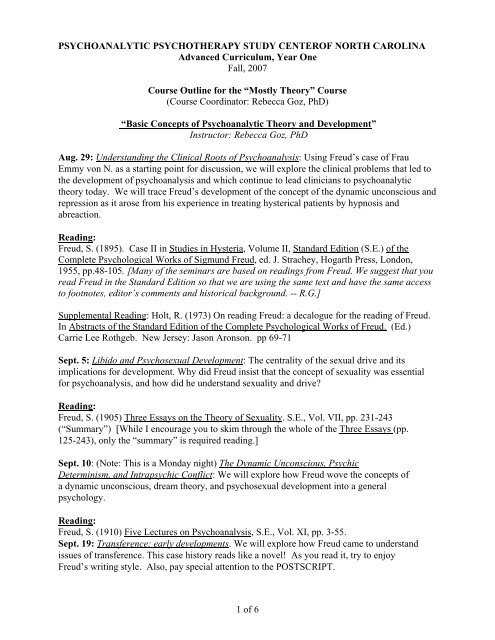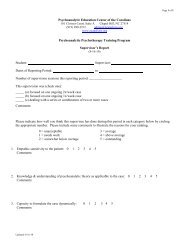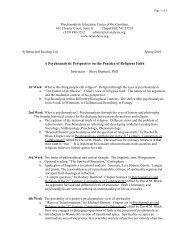âBasic Concepts of Psychoanalytic Theory and Developmentâ
âBasic Concepts of Psychoanalytic Theory and Developmentâ
âBasic Concepts of Psychoanalytic Theory and Developmentâ
You also want an ePaper? Increase the reach of your titles
YUMPU automatically turns print PDFs into web optimized ePapers that Google loves.
PSYCHOANALYTIC PSYCHOTHERAPY STUDY CENTEROF NORTH CAROLINAAdvanced Curriculum, Year OneFall, 2007Course Outline for the “Mostly <strong>Theory</strong>” Course(Course Coordinator: Rebecca Goz, PhD)“Basic <strong>Concepts</strong> <strong>of</strong> <strong>Psychoanalytic</strong> <strong>Theory</strong> <strong>and</strong> Development”Instructor: Rebecca Goz, PhDAug. 29: Underst<strong>and</strong>ing the Clinical Roots <strong>of</strong> Psychoanalysis: Using Freud’s case <strong>of</strong> FrauEmmy von N. as a starting point for discussion, we will explore the clinical problems that led tothe development <strong>of</strong> psychoanalysis <strong>and</strong> which continue to lead clinicians to psychoanalytictheory today. We will trace Freud’s development <strong>of</strong> the concept <strong>of</strong> the dynamic unconscious <strong>and</strong>repression as it arose from his experience in treating hysterical patients by hypnosis <strong>and</strong>abreaction.Reading:Freud, S. (1895). Case II in Studies in Hysteria, Volume II, St<strong>and</strong>ard Edition (S.E.) <strong>of</strong> theComplete Psychological Works <strong>of</strong> Sigmund Freud, ed. J. Strachey, Hogarth Press, London,1955, pp.48-105. [Many <strong>of</strong> the seminars are based on readings from Freud. We suggest that youread Freud in the St<strong>and</strong>ard Edition so that we are using the same text <strong>and</strong> have the same accessto footnotes, editor’s comments <strong>and</strong> historical background. -- R.G.]Supplemental Reading: Holt, R. (1973) On reading Freud: a decalogue for the reading <strong>of</strong> Freud.In Abstracts <strong>of</strong> the St<strong>and</strong>ard Edition <strong>of</strong> the Complete Psychological Works <strong>of</strong> Freud. (Ed.)Carrie Lee Rothgeb. New Jersey: Jason Aronson. pp 69-71Sept. 5: Libido <strong>and</strong> Psychosexual Development: The centrality <strong>of</strong> the sexual drive <strong>and</strong> itsimplications for development. Why did Freud insist that the concept <strong>of</strong> sexuality was essentialfor psychoanalysis, <strong>and</strong> how did he underst<strong>and</strong> sexuality <strong>and</strong> drive?Reading:Freud, S. (1905) Three Essays on the <strong>Theory</strong> <strong>of</strong> Sexuality. S.E., Vol. VII, pp. 231-243(“Summary”) [While I encourage you to skim through the whole <strong>of</strong> the Three Essays (pp.125-243), only the “summary” is required reading.]Sept. 10: (Note: This is a Monday night) The Dynamic Unconscious, PsychicDeterminism, <strong>and</strong> Intrapsychic Conflict: We will explore how Freud wove the concepts <strong>of</strong>a dynamic unconscious, dream theory, <strong>and</strong> psychosexual development into a generalpsychology.Reading:Freud, S. (1910) Five Lectures on Psychoanalysis, S.E., Vol. XI, pp. 3-55.Sept. 19: Transference: early developments. We will explore how Freud came to underst<strong>and</strong>issues <strong>of</strong> transference. This case history reads like a novel! As you read it, try to enjoyFreud’s writing style. Also, pay special attention to the POSTSCRIPT.1 <strong>of</strong> 6
PSYCHOANALYTIC PSYCHOTHERAPY STUDY CENTEROF NORTH CAROLINAAdvanced Curriculum, Year OneFall, 2007Course Outline for the “Mostly <strong>Theory</strong>” Course(Course Coordinator: Rebecca Goz, PhD)Reading:Freud, S. (1905) Fragment <strong>of</strong> an analysis <strong>of</strong> a case <strong>of</strong> hysteria. S.E., Vol VII, pp. 3-122.(POSTSCRIPT: pp. 112-122.)Sept. 26: Countertransference. Underst<strong>and</strong>ing psychoanalytic psychotherapy as a twopersonprocess.Reading:Werman, D.S. (1982) Countertransference, in Signs <strong>and</strong> symptoms in psychiatry.(Eds.) K.H. Brodie, <strong>and</strong> Cavenar, J.O., Philadelphia: Lippincott, pp. 357-391.Oct. 3: The Working AllianceReading:Greenson, R. (1967) Chapter 1, Section 1.33, pp. 45-48, in The Technique <strong>and</strong> Practice <strong>of</strong>Psychoanalysis, <strong>and</strong> Chapter 3, Sections 3.5 <strong>and</strong> 3.6, pp. 190-224. (There is a paper byGreenson on the same topic: (1965) The working alliance <strong>and</strong> the transference neurosis.Psa. Quarterly 34:155181.)Oct 10, 17, 24; Nov 7 Instructor Steve Bennett, PhDOct. 10: Dreams I: Window into the Unconscious “The Interpretation <strong>of</strong> Dreams” is Freud’sseminal <strong>and</strong> most important writing. In it can be found at least the beginnings <strong>of</strong> almost allFreud’s ideas about psychoanalytic theory. He called the dream “the royal road to theunconscious.” You should be familiar with “The Interpretation <strong>of</strong> Dreams” <strong>and</strong> its place inthe development <strong>of</strong> psychoanalysis. Today’s paper is Freud’s last statement on the subject <strong>of</strong>dreaming.Dreams II: Modern Views on Dreaming The discovery <strong>of</strong> REM sleep in the early 1950's<strong>and</strong> the enormous amount <strong>of</strong> research which has occurred in sleep an dreaming pr<strong>of</strong>oundlyaffect the psychoanalytic view <strong>of</strong> the dream <strong>and</strong> enormously influence our view <strong>of</strong> themental apparatus <strong>and</strong> how it functions.Reading:Freud, S. (1933) Revision <strong>of</strong> the theory <strong>of</strong> dreams (Lecture XXIX <strong>of</strong> The NewIntroductory Lectures on Psychoanalysis) S.E., Vol XXII, pp. 3-30.Supplemental Reading:Hawkins, D.R. (1990) Dreaming, neurobiology, <strong>and</strong> psychoanalysis. Psychiatric2 <strong>of</strong> 6
PSYCHOANALYTIC PSYCHOTHERAPY STUDY CENTEROF NORTH CAROLINAAdvanced Curriculum, Year OneFall, 2007Course Outline for the “Mostly <strong>Theory</strong>” Course(Course Coordinator: Rebecca Goz, PhD)Annuals 20, 5 (May 1990): 238-244.Hawkins, D.R. (1969) The challenge posed to dream theories by the new biology<strong>of</strong> dreaming: A Freudian view. In: Kramer, M.(ed.) Dream Psychology <strong>and</strong> theNew Biology <strong>of</strong> Dreaming. Springfield: Charles C. Thomas.Oct. 17: Instinct <strong>Theory</strong> This reading is a review <strong>of</strong> classic psychoanalytic concepts <strong>of</strong>instinct to the late 1960's. We will review these <strong>and</strong> then discuss more modern notions.Reading:Nagera, H., et al. (1970) Basic <strong>Psychoanalytic</strong> <strong>Concepts</strong> on the <strong>Theory</strong> <strong>of</strong> Instincts.London: George Allen <strong>and</strong> Unwin, Ltd., pp. 19-49.Oct. 24: The Development <strong>of</strong> the Structural <strong>Theory</strong>: Freud’s growing clinical experience <strong>and</strong> hisunflagging efforts to account for new findings led to the development <strong>of</strong> a new theory <strong>of</strong> mind inwhich mental events could be mapped within the interplay <strong>of</strong> id, ego, <strong>and</strong> superego.Reading:Freud, S. (1923) The Ego <strong>and</strong> the Id. S.E., Vol. XIX, pp. 3-66.Nov. 7: Evidence <strong>and</strong> <strong>Theory</strong> Making in Psychoanalysis. Plus, wrap-up <strong>and</strong> integration <strong>of</strong> issuesdiscussed. (Note: No reading assigned.)Nov. 14, 28; Dec. 5, 12; Jan. 9, 16, 2008 - Instructor Lisa Tust, PhD(NOTE 1: NO CLASS NOV 21 JUST BEFORE THANKSGIVING)(Note 2: Please Purchase: Tyson, Phyllis & Tyson, Robert (1990). <strong>Psychoanalytic</strong> Theories <strong>of</strong>Development Integration. New Haven: Yale University Press. Hardback or paperback, ok.Whatever edition you get will be easy to follow by topic, even if pages might be different).Nov. 14: Overview <strong>of</strong> the Developmental ProcessReading:Tyson, P. & Tyson, R. (1990) <strong>Psychoanalytic</strong> Theories <strong>of</strong> Development: An Integration,Chapters 1 (The history <strong>of</strong> the developmental perspective in psychoanalysis) & 2 (The theory <strong>of</strong>the developmental process.), pp. 7-41.Supplemental Reading:Pine, F. (1988) The four psychologies <strong>of</strong> psychoanalysis <strong>and</strong> their place in clinical work. JAPA36: 571-596.3 <strong>of</strong> 6
PSYCHOANALYTIC PSYCHOTHERAPY STUDY CENTEROF NORTH CAROLINAAdvanced Curriculum, Year OneFall, 2007Course Outline for the “Mostly <strong>Theory</strong>” Course(Course Coordinator: Rebecca Goz, PhD)Emde, R.N. (1988b) Development terminable <strong>and</strong> interminable: II. Recent psychoanalytictheory <strong>and</strong> therapeutic considerations. 35th International <strong>Psychoanalytic</strong> Congress (1987,Montreal, Canada). IJP 69:283-296.Dec. 12 Psychosexual Development: DrivesReading:Tyson, P. & Tyson, R. (1990) <strong>Psychoanalytic</strong> Theories <strong>of</strong> Development: AnIntegration, Chapters 3 (Psychosexuality: A theoretical overview) & 4 (The stages <strong>of</strong>psychosexual development), pp.41-69.Supplemental Reading:Fenichel, O. (1931) Specific forms <strong>of</strong> the oedipus complex. IJP 12: 412-430.Edgcumbe, R. & Burgner, M. (1975) The phallic-narcissistic phase: A differentiation betweenpreoedipal <strong>and</strong> oedipal aspects <strong>of</strong> phallic development. Psy. Study Child 30: 161-180.Parens, H., Pollock, L., Stern, J., Kramer, S. (1976) On the girl’s entry into the Oedipus complex.JAPA 24: 79-107.HOLIDAY BREAKJanuary 9, 2008 Psychosexual Development: EgoReading:Tyson, P. <strong>and</strong> Tyson, R. (1990) <strong>Psychoanalytic</strong> Theories <strong>of</strong> Development: AnIntegration, Chapter 18 (The development <strong>of</strong> the ego), pp. 295-321.Supplemental Reading:Hartmann, H., Kris, E., & Loewenstein, R. (1946) Comments on the formation <strong>of</strong> psychicstructure. Psy. Study <strong>of</strong> Child 2: 11-38.Reich, W. (1931) The characterlogical mastery <strong>of</strong> the Oedipus complex. IJP 12: 452 467.Freud, A. (1936) The ego <strong>and</strong> the mechanisms <strong>of</strong> defense. In: A. Freud, ed.: The Writings <strong>of</strong>Anna Freud, Vol. 2, pp. 1-179. New York: IUP.Abraham, K. (1926) Character-formation on the genital level <strong>of</strong> libido development. IJP 7: 214-222.Jan. 16, 2008: Psychosexual Development: Superego5 <strong>of</strong> 6
PSYCHOANALYTIC PSYCHOTHERAPY STUDY CENTEROF NORTH CAROLINAAdvanced Curriculum, Year OneFall, 2007Course Outline for the “Mostly <strong>Theory</strong>” Course(Course Coordinator: Rebecca Goz, PhD)Reading:Tyson & Tyson (1990) <strong>Psychoanalytic</strong> Theories <strong>of</strong> Development: An Integration, Chapters 12(The superego: A theoretical overview)& 13(The development <strong>of</strong> the superego), pp. 195-228.Supplemental Reading:Arlow, J.A. (1982) Problems <strong>of</strong> the superego concept. Psy. Study Child 37: 229-244.Silverman, M. (1986) The male superego. PR 73: 427-444.Tyson & Tyson (1990) <strong>Psychoanalytic</strong> Theories <strong>of</strong> Development: An Integration, Chapter 14(Gender differences in superego development), pp. 228-249.Alpert, Judith, <strong>and</strong> Jody B. Spencer (1986) Morality, gender, <strong>and</strong> analysis. In: Psychoanalysis<strong>and</strong> Women: Contemporary Reappraisals, ed. Judith Alpert. Hillsdale, NJ: Analytic Press, pp.83-111.6 <strong>of</strong> 6




